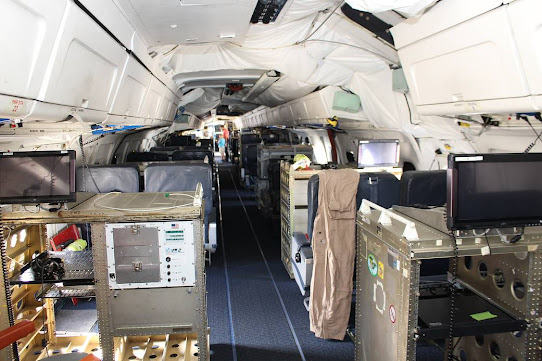In 1952, the Douglas Aircraft Company began work on a project that, six years later, had morphed into the DC-8, a four-engine jetliner that helped revolutionize air travel. Taking to the skies for the first time on May 30, 1958, the DC-8 would go on to remain in production for nearly 15 years, with more than 500 of the aircraft constructed.
One specific DC-8-72 was purchased and put into service in
1969 by Alitalia, before Braniff purchased this plane and implemented it as a
member of its fleet from 1979 to 1986. At that point, this aircraft was
repurposed from passengers to science when NASA took possession of it. The aerospace
and sciences agency began outfitting it with entirely new capabilities, turning
it into what has been described as “the world’s largest flying laboratory.”
NASA’s DC-8 is based at the Armstrong Flight Research Center
in Edwards, California, and is rarely seen on the East Coast. But in recent weeks
N817NA has been temporarily based at Ohio’s Wright Patterson Air Force Base, making a
number of research flights over eastern cities, scientifically barnstorming at
very low altitudes of just over 1000 feet.
It’s all part of a months-long, national project under the auspices of NOAA (National Oceanic and Atmospheric Administration) called AEROMMA, the acronym far more easily said than the study’s official title: “Atmospheric Emissions and Reactions Observed from Megacities to Marine Areas.” In conjunction with several smaller aircraft in NASA’s fleet, the DC-8 is helping to gather data on pollution sources and levels in the vicinity of major metropolitan areas, including New York City, Chicago, Detroit, and Toronto.
One typical AEROMMA flight took place on August 16, when the DC-8 took off in Ohio with a flight plan filed for a Trenton, NJ destination. But rather than landing at Trenton Mercer Airport, NASA used that location as an aerial inception point. Typically, NASA uses the plane for high-altitude research, but on this day its DC-8 descended to a low altitude before embarking on a precise course north from Trenton over the New York area, meticulously repeating past project flights for accurate comparison. When collecting data over water, the DC-8 dropped as low as 500 feet.
N817NA’s days of flying into dramatic skies will be coming to an end in the months to come, the plane having flown for well over five decades.
Seeing any DC-8 in the skies of 2023 is an extremely rare
sight – only five remain airworthy in the world. And that number will decrease
in a matter of months, as NASA plans to retire its DC-8 in favor of a newer
Boeing 777 obtained from Japan Airlines in 2020. Work to install laboratory
instrumentation into this newer aircraft is ongoing at NASA Langley Research
Center in VA. For now, though, N817NA’s research flights continue, and its
graceful beauty in the skies calls to mind an earlier era of aviation.
For more on NASA’s flagship DC-8 research plane and the
agency’s entire fleet visit:





